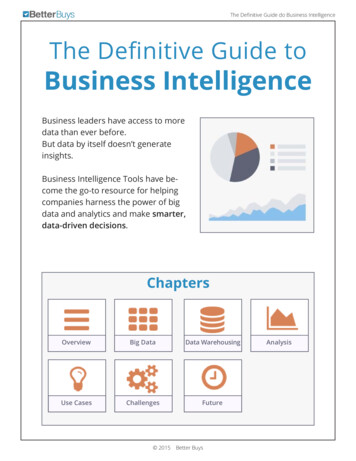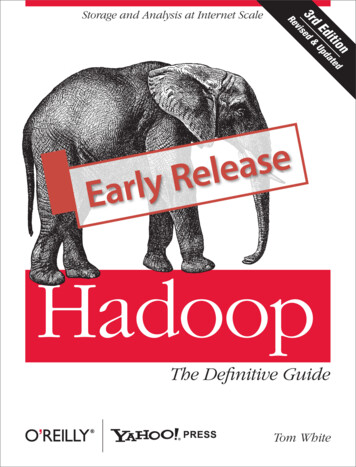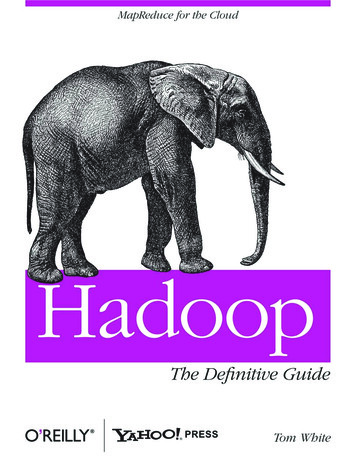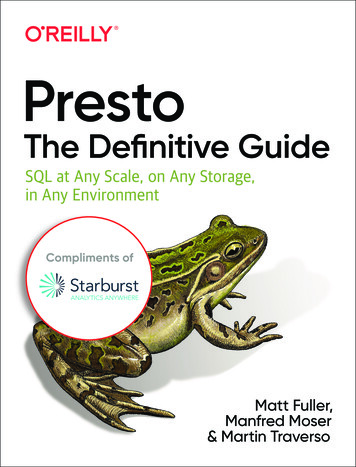
Transcription
The Definitive Guide do Business IntelligenceThe Definitive Guide toBusiness IntelligenceBusiness leaders have access to moredata than ever before.But data by itself doesn’t generateinsights.Business Intelligence Tools have become the go-to resource for helpingcompanies harness the power of bigdata and analytics and make smarter,data-driven decisions.ChaptersOverviewBig DataData WarehousingUse CasesChallengesFuture 2015Better BuysAnalysis
The Definitive Guide do Business IntelligenceWhat is Business Intelligence?The specific definition of BI can vary depending on who you ask.Here are a few examples of some of the ways business intelligence is defined:A variety of software applications used to analyze an organization’s raw data.A broad category of computer software solutions that enables acompany or organization to gain insight into its critical operationsthrough reporting applications and analysis tools.A set of methodologies, processes, architectures, and technologiesthat leverage the output of information management processesfor analysis, reporting, performance management, and information delivery.Technologies, applications and practices for the collection, integration, analysis, and presentation of business information.The use of computing technologies for the identification, discoveryand analysis of business data – like sales revenue, products, costsand incomes.In our view, each of those definitions is incomplete.Many of them are focused only on the software used for business intelligence. While the termis often heard in relation to software vendors, there’s more to BI than just software tools.In addition, many of the common definitions of BI neglect to include the primary goal ofbusiness intelligence.Our definition of BI is as follows:Business Intelligence helps derive meaningful insights from raw data. It’s an umbrellaterm that includes the software, infrastructure, policies, and procedures that can leadto smarter, data-driven decision making. 2015Better Buys
The Definitive Guide do Business IntelligenceHistory of Business IntelligenceThe term “business intelligence” has been around for decades, but it was first used as it istoday by Howard Dresner in 1988.Dresner defined business intelligence as the “concepts and methods to improve businessdecision making by using fact-based support systems.”Today, business intelligence is defined by Forrester as “a set of methodologies, processes,architectures, and technologies that transform raw data into meaningful and usefulinformation used to enable more effective strategic, tactical, and operational insights anddecision-making.”In the first stages of businessintelligence, IT teams ranreports and queries for thebusiness side, though today’ssystems are focused more onHoward Dresnerdefines “BusinessIntelligence” as weknow it today1988enabling self-service intelligencefor business users.1990As with any technology, theofferings from vendors haveReports andqueries are initiallyrun by ITevolved over time and continueto do so. As core featureslike reporting and analyticsare becoming commoditized,vendors are looking at otherThe term“BusinessIntelligence”becomes widelyused1997features to differentiatethemselves. Likewise, as thebusiness environment changes,1999so do the requirementsorganizations have fortheir business intelligenceapplications.These are a few of the biggesttrends and developments in“Saas” acronymfirst appears Software As AServicebusiness intelligence right now: 2015Better Buys2001PredictiveAnalytics beginsto change howbusinessesoperate
The Definitive Guide do Business Intelligence The blending of softwareand consulting services– Vendors are beginning2005to offer “information asa service” and presentingintelligence to clients, asopposed to selling thesoftware and infrastructurebusinesses need to accessAdoption grows:35% employpervasive BIRise insocial mediageneratesexponentialincrease indata2010intelligence on their own. Increasing Self-service –Software is increasingly2014focused on increasingthe functions that areBI Marketreaches 81 billionperformed withouthaving to involve IT staffor data scientists. Cloud-based businessBI Marketexpected tosurge to 136 billion2018intelligence – While cloudcomputing has taken holdin other areas, it’s beginningto catch on in businessintelligence, too. As this progresses, it will allow businesses to use intelligence withoutdedicating internal resources to manage infrastructure and perform software upgrades. Mobile intelligence – Mobile is becoming a key part of day-to-day business and it’sno different in business intelligence. Mobile tools allow decision makers to accessintelligence wherever they need it, not just when they’re at their desks. Big Data – Businesses have access to more data than ever, and a lot of it comes fromoutside the organization in non-structured form. Business intelligence is increasinglybeing combined with Big Data analytics, so businesses can make decisions using all theinformation they have at their disposal, regardless of what form it takes. 2015Better Buys
The Definitive Guide do Business IntelligenceComponents of Business IntelligenceWhile ideally the end result of business intelligence is not complex, there is a lot of complextechnology involved in turning raw data into actionable information. Here are a few of thecore components of a typical business intelligence deployment:Source DataBusiness intelligence all starts with the data.As we mention above, businesses have access to more datathan ever. Much of that comes from transactional systems,such as CRM systems, ERP systems, inventory databases, HRand payroll systems, and many others.Data used in BI also comes from external sources. One common source is social media,which organizations use to capture statements in which users mention the company. Othersources can vary greatly depending on what questions the organization is trying to answer,but may include public data from government reports, weather information and industrynews reports.Extract, Transform, Load (ETL)Simply having access to the data doesn’t mean it’s ready to beused for intelligence.A key part of BI is the tools and processes used to prepare datafor analysis. When data is created by different applications, it’snot likely all in the same format, and data from one applicationcan’t necessarily be looked at in relation to data from another. In addition, if businessintelligence is relied on to make critical decisions, businesses must make sure the datathey’re using is accurate.The process of getting data ready for analysis is known as Extract, Transform, Load (ETL).The data is extracted from internal and external sources, transformed into a commonformat, and loaded into a data warehouse. This process also typically includes dataintegrity checks to make sure the data being used is accurate and consistent. 2015Better Buys
The Definitive Guide do Business IntelligenceData WarehouseA data warehouse is a repository containing information fromall the business’s applications and systems, as well as externalsources, so it can be analyzed together.The ETL process ends with data being loaded into thewarehouse, because when the data is contained within theseparate sources, it’s not much use for intelligence. That’s fortwo primary reasons. First, those sources are typically applications that are designed forprocessing transactions, not for performing analysis. Analyzing the data in that state wouldtake too long and disrupt critical business operations.Second, the point of business intelligence is to gain more insight about the organization asa whole, so the data from all of those systems must be combined in order to understand asingle, holistic view of what’s happening in the company.Online Analytical Processing (OLAP)The data warehouse and ETL process represent the back endof business intelligence, while Online Analytical Processing(OLAP) represents the front end. OLAP tools present data tousers and allow them to group, aggregate and sort the databased on various criteria.This is the function that allows users to pull out the data theywant and make the comparisons they need in order to havetheir questions answered.VisualizationsAs mentioned above, one of the goals of business intelligenceis to make data accessible and useful to non-technical businessusers. As such, data must often be transformed into somethingbeyond spreadsheets and lists of numbers so that it can beproperly understood.Visualization tools present data using charts, graphs andother formats to aid understanding. Traditional formats include bar graphs, pie charts and 2015Better Buys
The Definitive Guide do Business Intelligencescorecards, while advanced data visualization can create interactive and dynamic content,automatically choosing the best type of representation and personalizing content for the user.DashboardsThe dashboard is the primary graphical interface used whenworking with a business intelligence system. Typically the firstthing the user sees when logging on, the dashboard presentsthe most important reports and data visualizations for theuser, customized based on the person’s role.The dashboard is a simple way to organize information in oneplace and allow the user to dig deeper for more.Goals of Business IntelligenceWhy do companies use business intelligence? The primary goal is stay ahead of thecompetition and make the right decision at the right time. Those decisions can be madearound pretty much any aspect of running a business, such as: Figuring out how to increase the effectiveness of marketing campaigns Deciding whether and when to enter new markets Improving products and services to better meet customers’ needsOne of the key aspects of business intelligence is that it’s designed to put information in thehands of business users. Organizations are required to make decisions at an increasinglyfaster pace, so today’s business intelligence tools help decision makers access theinformation they need without having to first go through the IT department or specificallydesignated data scientists.Rather than request a report and then wait for it to be created, the user can log into thebusiness intelligence application and view all the critical information presented in way thatdoesn’t take a specialist to understand.Since the goal is to help business leaders use intelligence to make better decisions, BItools must be easy for those users to understand 2015Better Buys
The Definitive Guide do Business IntelligenceBest Practices for Business IntelligenceAs mentioned above, business intelligence is more than just software. For a successfulimplementation, businesses need to have the right processes and infrastructure in place inaddition to the right business intelligence applications.Unfortunately, a lot of implementations aren’t successful. According to a 2011 report fromGartner, 70%-80% of business intelligence projects fail.In order to prevent that, here are some of the best practices organizations should followwhen they formulate their business intelligence strategy:1 Decide whether you need business intelligenceThere’s a lot of hype around business intelligence, and many companies may make themistake of investing a lot of money into the technology just because they think they needto. Instead, the organization must first be clear on what it wants to accomplish and identifya specific business need business intelligence can help solve.According to Gartner, one of the top reasons for such a high failure rate is that manyorganizations assume that business intelligence is a requirement, rather than fullyunderstanding the needs of the business.Figuring out what those needs are should be the first step in any business intelligencestrategy. The key is for IT and the business units to work together to list the needs anddetermine how and if they can be met using business intelligence, and whether businessintelligence or some other solution is needed.2 Standardize systems and processesEven when a business intelligence project is completed and all the necessary componentsare installed and deployed, that doesn’t mean the organization is getting the most out ofits investment.One reason businesses run into challenges is because they rely on many different systemsand applications used throughout the organization. That makes it hard to get a holisticview of the company and the “single version of the truth” that is critical to businessintelligence success. 2015Better Buys
The Definitive Guide do Business IntelligenceOnly 35% percent of organizations have standardized on one or a few business intelligenceproducts throughout the company, according to InformationWeek’s 2014 Analytics, BI, andInformation Management Survey. The rest use different software and systems in differentbusiness units. However, a successful business intelligence should come from the top down,with standardized tools and process that work for all departments. It helps to have the entireorganization involved from the beginning so that everyone’s input is taken into account.3 Focus on usabilityWhen evaluating software options, it’s especially important to pay attention to how easythe systems are for the people who will use them on a regular basis. Executives, managersand others from the business side are increasingly using business intelligence tools withoutthe help of IT, analysts and others.Software should have self-service functionality and the ability to display information andreports in a way that the average business person can understand. Again, this is one areain which it helps to have input from everyone during the planning stages.In addition, the business also needs to give people the right training so they can get themost of the tools that are selected. If the company simply hands access to people who areused to getting all of their information from spreadsheets, they likely won’t get much out of it.4 Get the data readyGood intelligence starts with good data. When asked what was their biggest barrier tosuccessful business intelligence initiative, 59% of respondents in InformationWeek’s surveyanswered data quality issues.Coming up with a plan for a business intelligence deployment takes more than justdeciding what software to use. A key piece is figuring out a strategy to ensure data quality.Businesses must look at what data they have or will be able to capture, and decide whatthey need and how they ensure its integrity.According to Aberdeen research, data quality must be addressed first, before any otheraction is taken. Companies with the most success in business intelligence are those thatinvest in tools and processes to make sure records are complete and accurate. Governanceprocesses must also be used to avoid data duplication and make sure old, outdated, or nolonger-relevant data is deleted. 2015Better Buys
The Definitive Guide do Business IntelligenceBig DataIt’s been one of the most talked about andhyped tech concepts of the past few years.In fact, it’s almost impossible to read anyinformation about analytics – especiallyinformation from software companies –without hearing about Big Data.But what does it really mean?What is Big Data?Companies have a lot of data.Much of it is structured, meaning it can be organized in a database or Excel spreadsheetand sorted using simple criteria.For example, a spreadsheet listing purchases would include columns for customer name,amount invoiced, product name, date, etc. All of those fields are standardized and can befiltered or sorted alphabetically or numerically.However, a lot of the data companies have is unstructured, and the amount ofunstructured data at organizations’ disposal is quickly increasing. This includes anythingthat doesn’t fit neatly into rows and columns, such as: Collections of statements people are making about the company on social media Audio recordings and transcriptions of calls with customer service agents Website search indexes Videos, images and data from various types of sensorsBig Data is any data that can’t be managed using conventional database tools. 2015Better Buys
The Definitive Guide do Business IntelligenceIn addition to just the type of information it contains, there are also other factors that makeBig Data big.According to IBM’s “4 V” definition, those factors include the data’s: Velocity – The interconnectivity of people and things via technology is generating datacontinuously, and businesses are attempting to capture and analyze it in real time. Variety – Big Data comes from many different sources and includes many differenttypes of information. Sets of data typically can’t be simply compared to one anotherusing traditional tools. Volume – As the phrase implies, Big Data includes, simply, a lot of data. Individualcompanies have access to a lot of it, with terabytes, petabytes, and soon zetabytesbeing stored and collected. Veracity – With so much data from different sources being collected, there can bea lot of doubt about the accuracy and consistency of that data. However, in order toget actual value from Big Data, it’s important to have tools and processes in place toverify and clean up the data.As with business intelligence, there are many varied definitions of Big Data floating around.One issue is that many of the definitions are driven by software vendors and tend to drive upthe hype of the technology, rather than focus on what Big Data actually means for businesses.Some examples of existing definitions of Big Data include:Big data is high-volume, high-velocity and high-variety informationassets that demand cost-effective, innovative forms of informationprocessing for enhanced insight and decision making.Big Data is a collection of data from traditional and digital sourcesinside and outside your company that represents a source forongoing discovery and analysis.Big Data is used to refer not just to specific types of data, but alsothe technologies used to manage them.Big Data is an evolving term that describes any voluminous amountof structured, semi-structured and unstructured data that has thepotential to be mined for information. 2015Better Buys
The Definitive Guide do Business IntelligenceFor our definition, we wanted to highlight what sets Big Data apart from other types ofdata, as well as touch on why it’s important for businesses:Big Data is any data that can’t be managed using conventional database tools but canstill be analyzed to create valuable insight for the organization.Big Data: Challenges and OpportunitiesThe volume of Big Data is a critical point that’s creating a lot of new challenges forcompanies. As business and other aspects of life become more digital, there’s a lot of bothstructured and unstructured data being created all the time.As companies try to mine intelligence from that data, thatmeans they’ve got a lot of information to store, and thatvolume is growing exponentially.According to predictions from IDC, the total amount ofdata stored in the digital universe will grow from 4.4zetabytes in 2013 to 44 zetabytes in 2020. A zetabyte,for your reference, is one trillion gigabytes. Total data isdoubling in size every year, and businesses are expected tocreate 44 times and much data in 2020 as they did in 2009.Data with value – if you know howto capture itBusinesses will have a lot of opportunities to utilize andbenefit from that data. Despite the fast growth, IDCestimates that, thanks to new tools and techniques, 37% ofall the data a business has access to in 2020 will be usefulif properly analyzed, compared to 22% in 2013.Despite the challenges associated with storing andmanaging all of that data, the vast majority (89%) ofdatabase professionals consider Big Data to be a greatopportunity to improve business results, rather than acostly data management problem, according to a 2013TWDI survey. 2015Better Buys
The Definitive Guide do Business IntelligenceSpecifically, business leaders polled by Harris Interactive on behalf of SAP said they expectthese benefits from Big Data analytics: More efficient business operations (cited by 59% of respondents) Increased sales (54%) Lower IT costs (50%) More agile operations (48%) Increased ability to attract and retain customers (46%)Challenges remainHowever, there are a lot of challenges still in the way before organizations realize all of BigData’s potential benefits.Businesses must adapt and deploy the right tools to be able to store, analyze and secure Big Data.As mentioned above, traditional tools aren’t equipped to process this new data; newsoftware and systems such as Hadoop are required. Also, specialized storage tools areneeded, along with tools to extract and integrate Big Data from various sources.As with the Extract, Transform and Load (ETL) tools used for business intelligence, there’s alot of work to be done to gather Big Data, ensure its quality and get it ready for analysis.Some of the other challenges standing in the way of Big Data benefits include:1. Lack of skilled staff – Big Data has taken off fairly recently, and as such manycompanies report difficulty in finding staff with the skills necessary to manage thisnew data. In fact, that was the top challenge listed in TDWI’s report, cited by 40% ofrespondents. One strategy to combat that could be to offer employees Big Data trainingin order to grow the talent pool internally.2. Data governance issues – With so much data available, it becomes even morecritical to have a framework in place for deciding what data belongs in the system.However, just 30% of the companies surveyed by TDWI said that data governanceteams were heavily involved in Big Data management.3. Organizational readiness – As with business intelligence, successfully analyzing BigData takes more than just installing software and other tools. The entire organizationneeds to be on the same page, and there must be a clearly articulated strategy builtaround actual business goals. 2015Better Buys
The Definitive Guide do Business IntelligenceBig Data Use CasesSo why do companies use Big Data?For the same reasons they use other forms of analytics and business intelligence. Thegoal is to analyze these new types of data and use the knowledge gained to make betterdecisions for the business.Some of the most common use cases for Big Data analytics include:1 Getting a more complete view of the customerIn order to better serve current customers and find ways to attract new ones, businessestry to know as much about customers as possible. According to InformationWeek, one ofthe most common uses of Big Data is to use it to help augment traditional data sourceslike purchase history with clickstream data showing what customers have done on thecompany’s website, as well as data gathered from social media sites.2 Using external data for decision makingBig Data doesn’t just include the data generated by the company and its customers.There’s also a lot of information from a lot of other sources that can be valuable for makingdecisions or developing strategies. For example, crmsearch.com cites one hotel chain thatanalyzes weather data and information about flight cancellations to deliver mobile adstargeted to stranded travellers who need to book a room for the night. In a similar strategy,a pizza chain also uses weather and power outage data to target ads to customers whohave lost power and are unable to cook.3 Spotting trends that may have gone unnoticedBig Data can also be used to help organizations predict future trends and plan for thelong term. CIO.com cites the example of a university health system analyzing healthdata in municipalities to spot trends in factors such as population growth and chronicdisease diagnoses to gauge whether those regions are being adequately served by localhealthcare facilities.Big Data can help companies know more about their customers, their industry, andanything else they want to learn more about. 2015Better Buys
The Definitive Guide do Business IntelligenceBig Data vs. Business IntelligenceBig Data and business intelligence are related and are often used in conjunction, butthey’re not exactly the same.They each have the same purpose and goal: to use available data in order to learn more about abusiness, its markets and its customers in order to make better, more successful decisions.The difference lies in the types of data being analyzed, which affects the kinds of questionsa business can ask.“Business intelligence helps find answers to the questions you know. Big Data helpsfind the questions you don’t know you want to ask.” – IT Consultant & Blogger EricBrownWhen analyzing only structured data using business intelligence, you ask the system to run areport around certain parameters. You can dig into the report to get more detail, but you stillneed to request the specific information you’re looking for. Big Data analysis, on the other hand,is more about allowing the system to sift through the data to find new patterns and insights.The tools and infrastructure used for Big Data and business intelligence also vary.Business intelligence requires loading structured data from transactional systems and othersources into a traditional data warehouse, where it’s used to run queries and produce analytics.In Big Data, specialized applications such as Hadoop are required. Unstructured data is fed fromvarious sources into that system where it’s accessed by Big Data applications.Of course, business leaders don’t care very much about the specific differences betweenBig Data and business intelligence.Different investments will be made depending on what the organization needs, but inthe end, if the goal is to use the data available to make the best decisions possible for thebusiness, it doesn’t matter whether that data is structured or unstructured, where it comesfrom, or what software is performing the analysis.That’s why today, business intelligence and Big Data are often combined. That puts all thevaluable information in the same place so users can get a complete look at their businesswith full, accurate insights.Many vendors are now beginning to add Big Data capabilities to their business intelligenceofferings, and many businesses use a data warehouse filled with both structured andunstructured data. 2015Better Buys
The Definitive Guide do Business IntelligenceBig Data SkepticismAs with any widely hyped technology or product, companies need to ask themselves areally important question about Big Data: Do businesses really need it?Despite the hype, the answer, of course, is that it depends. That’s not to say that Big Data isgood or bad or valuable or not, just that organizations need to be careful in deciding if BigData is right for them.Here are a few questions businesses can ask when trying to make that decision:1 Is our data big enough?As with traditional business intelligence, the point of Big Data is to use data to answerquestions. So when making a decision, companies need to start by figuring out whatquestions they want answered, or at least in which specific areas they would like moreinsight, as well as what data they have or are able to access.For example if all you want to know is who is buying what and where, you probably don’tneed Big Data to find the answers. Structured data in a traditional database will do thetrick. Also, remember that volume isn’t the only key attribute in the definition of Big Data.Having a lot of structured data doesn’t make it big.2 Is your data relevant to your business?It’s important to tie the questions you have in mind and the data you will analyze to actualbusiness results. Business leaders may ask questions out of curiosity, and data from newsources can certainly reveal information about an organization that is interesting, butimplementing a Big Data solution is a complex, resource-intensive process, so it shoulddeliver a real, measurable impact.3 Is your organization ready?As with business intelligence, getting ready to use Big Data takes more than just installingsoftware. Organizations need to be ready for their implementations to be successful. Thatincludes both hardware as well as other considerations.One aspect companies may struggle with is the sheer amount of information being 2015Better Buys
The Definitive Guide do Business Intelligencecollected and stored. That may require an upgrade in hardware or the purchase ofadditional servers. Hadoop is known for being able to run on “industry-standard” hardware;however, as InformationWeek points out, companies may find their own goals requiredifferent hardware configurations.Organizations must also make sure they have the right processes in place for collectingthe right data, ensuring its integrity and maintaining data governance. And perhapsmore importantly, effectively using Big Data or any other kind of analytics may require asignificant culture change.However, according to the report from the Economist and Terradata, organizations tendto focus on the necessary cultural changes last, and technology and tools first. The reportlisted two key success factors necessary for building a culture ready to tackle Big Data andadvanced analytics: Top-down leadership – It’s critical that decision makers at the top make it clearthat analytics will form the basis for decision-making. Tying Big Data initiatives toorganization-wide decision making will help keep those initiatives on track and showthe rest of the business that the analytics work is valuable. Bottom-up engagement – Strong leadership will help bring employeesthroughout the organization on board. Other keys are making analytics tools easy touse, offering training and support, and aligning the work with day-to-day businessgoals and tasks.Big Data represents the potential for new kinds of decision making, according to McKinsey& Company. Organizations and people used to making decisions based on assumptionsmust learn how to change course when
data than ever before. But data by itself doesn’t generate insights. Business Intelligence Tools have be-come the go-to resource for helping companies harness the power of big data and analytics and make smarter, data-driven decisions. Chapters Overview Big Data Data











